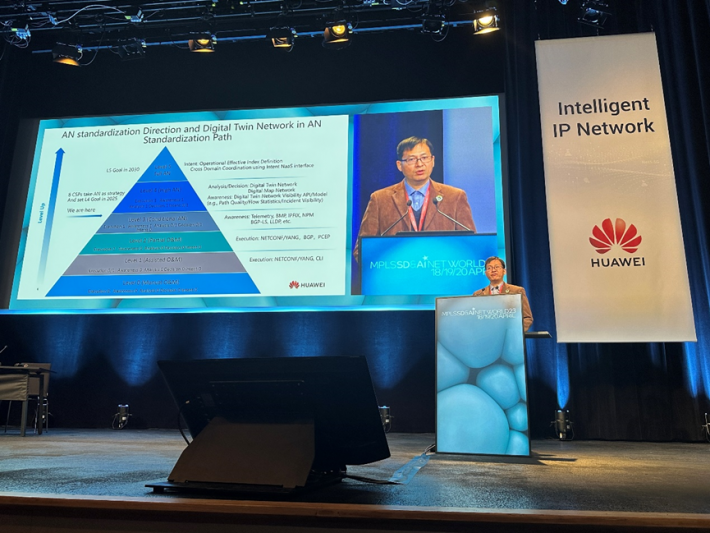(Sponsored News) At the MPLS SD & AI Net World Congress 2023, Wu Qin, a distinguished member of IETF IAB, presented an insightful speech titled “Digital Twin Networking for Network Management Automation Transformation” during the Management and Orchestration Session.
Wu delved into the three critical challenges in constructing Digital Twin network, also known as Network Digital Map, and discussed how to transition network management toward a data-driven automated paradigm. To address these challenges, Wu proposed a standard architecture for Digital Twin Network, along with a suite of key technologies required for its implementation.
Wu also underscored the importance of Network Digital Map as a key enabler for achieving L4 in Autonomous Networks (AN). Network digitalization is one of the four primary technological trends in the evolution toward AN. Network digitalization encompasses large-scale network model digitalization within controllers and northbound interface (NBI) digitalization, commonly called network visibility. The primary objective of digitalization is to dismantle data silos and construct a comprehensive digital platform.
- An end-to-end (E2E) network measurement tool is unavailable. Data is collected using IT methods, such as telemetry, leading to data silos with interoperability issues. This makes it challenging to correlate various data types and pinpoint the root causes of network problems.
- Conducting tests and verifying configurations on the live network result in increased costs. Given that 70% of network exceptions are due to improper configurations, introducing service innovations will likely disrupt existing services.
- The unavailability of a tool designed to test and verify network policies and the lack of collaboration between controllers and analyzers necessitate human involvement during network optimization.
Architectural Design
Network Digital Map is a method for managing physical networks in the digital world. It implements real-time network visualization, simulated path navigation, and online optimization. Wu introduced the Digital Twin Network architecture, which offers multidimensional network visualization, network as a service (NaaS) APIs oriented to planning/construction/maintenance/optimization, and configuration intent simulation/verification. It has been adopted by many standards organizations (such as IETF).
Key Technologies
- For closed-loop automated network management and network optimization, various digital network visualization technologies, including network topology visualization, port visualization, and path quality visualization, are required. IETF has adopted these technologies.
- NaaS API technologies, such as service provisioning, service assurance, and intelligent O&M, are key enablers for the planning, construction, maintenance, optimization, and operation of Digital Twin Network (Network Digital Map). In addition to visualizing services in an E2E fashion and optimizing networks proactively, these technologies facilitate single-domain autonomy, cross-domain orchestration, and E2E service lifecycle management. Intelligent incident management, a typical NaaS API technology, addresses the issue of ambiguous connections between alarms and services. By linking network services to events, such as KPIs, alarms, and notifications, it significantly reduces the number of superfluous trouble tickets and improves network O&M efficiency.
Online network simulation/verification is another core technology in Digital Twin Network (Network Digital Map). It evaluates and verifies network configuration changes, preventing improper configurations from disrupting live network services. Furthermore, it performs real-time measurement and optimization of the network. If link traffic exceeds the threshold, it automatically adjusts the paths of low-priority services to relieve network congestion or redirects traffic to low-risk paths.
Network Digital Map (Digital Twin Network) has been deployed worldwide and is extensively used in vertical industries (including finance), 5G transport, and cloud-network private lines.
In the concluding segment of his speech, Wu showcased two carrier use cases to demonstrate how Network Digital Map, by employing KPI-network topology association and network path computation/navigation, assists carriers in reconstructing the network topology, improving network quality, and ultimately building a self-optimizing, self-healing, and congestion-free transport network. Network Digital Map will increasingly aid customers in establishing a comprehensive digital platform, thereby accelerating their progress toward L4 AN.






